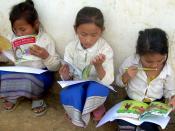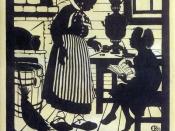Description: This essay looks at the development of literacy from birth to school age including speaking, listening, viewing, reading and writing. It examines the 'nature vs nurture' controversy and how these aspects help to aid a childs overall literacy development.
The Development of Literacy Amongst Young Children
From the day children are born they require a form of communication in order to function adequately in society. A pre-speech baby will use gestures and expressions and babblings to interact with others. A toddler will participate in turn taking to satisfy a need or want. The more pre-schoolers participate in the world, the more they discover that language is useful. They also realise the potential of language for expressing their thoughts and feelings. From bedtime stories to a parent playing a game of "peek-a-boo", children begin to develop their language from the time they are born.
This essay will look at the development of emerging literacy from birth to school age.
The concept of language and literacy refers more directly to speaking, listening, viewing, reading and writing. Emerging literacy relates to the reading and writing skills that are within children from birth. Through external forces, these developments, or skills will surface under the right conditions.
Children are born ready to communicate. Before children begin school, they have already experienced 5-6 years of literacy experience (Display appendix 1). The degree to which the experience shape the children's literacy behaviours and development depend on external influences. These influences include children's play experiences, interactions with adults and cultural and environmental influences. During this session, the following issues will be discussed:
The interaction speaking, listening, reading, writing, viewing and thinking development.
How children's literacy behaviours are promoted and shaped by:
Early cultural and environmental influences.
Children's play experiences.
Interactions with adults.
Methods staff can...


